Factor Olympics 1H 2018
And the Winner is…
July 2018. Reading Time: 10 Minutes. Author: Nicolas Rabener.
SUMMARY
- Factor performance in 1H 2018 is comparable to 2017
- The Size factor has taken the lead, likely reflecting the threat of global trade wars
- Value has generated the most negative returns across regions
INTRODUCTION
We present the performance of seven well-known factors on an annual basis for the last 10 years and the first half of 2018. It is worth mentioning that not all factors have strong academic support, e.g. Growth lacks a long-term track record of positive excess returns; however, is still a widely-followed investment style (read Factor Olympics Q1 2018).
METHODOLOGY
The factors are created by constructing long-short beta-neutral portfolios of the top and bottom 10% of stocks in the US, Europe and Japan and 20% in smaller markets. Only stocks with a minimum market capitalisation of $1 billion are included. Portfolios rebalance monthly and transactions incur 10 basis points of costs.
FACTOR OLYMPICS (LONG / SHORT): GLOBAL
The table below shows the factor performance for the last 10 years ranked top to bottom. The global series is comprised of all developed markets in Asia, Europe and the US. Aside from displaying the factor performance the analysis highlights the significant factor rotation in terms of profitability from one year to the next.
The first half of 2018 shows largely a continuation of 2017, i.e. Growth, Momentum and Quality generated positive returns while Value and Dividend Yield were negative. The Size factor generated the strongest returns in Q2 as the performance was flat in Q1 and has taken performance leadership since then. The strong performance of small caps can likely be explained by the threat of global trade wars, which are based on policy changes of the US government. Investors anticipate that smaller companies will be less negatively impacted by trade tariffs than larger companies.
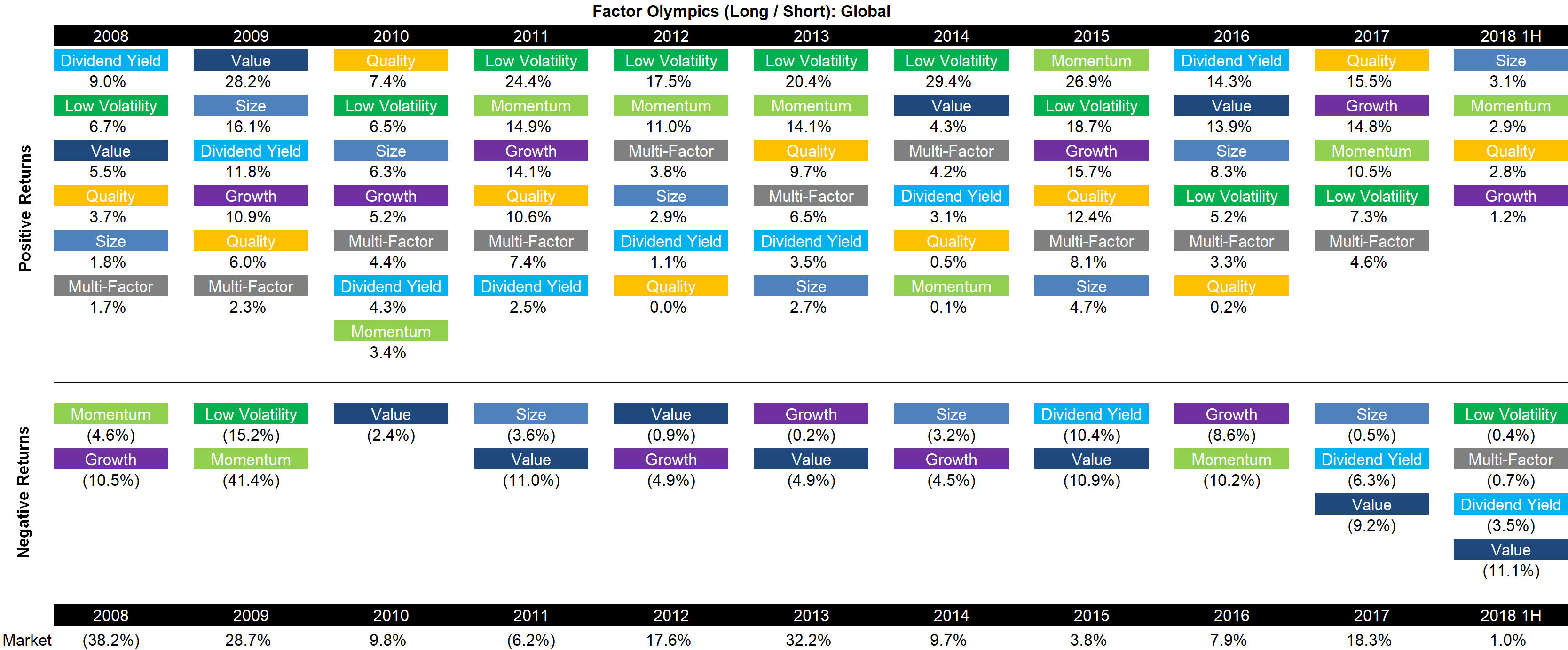
Source: FactorResearch
FACTOR PERFORMANCE 1H 2018: US
The table above reflects the global factor performance and it is interesting to analyse how homogeneous the performance is across regions. The global performance is significantly weighted towards the US, so it is not surprising that factor performance in the US is very similar to the global returns.
In H1 2018 the US economy showed strong growth and low unemployment, which has led to rising interest rates. The Low Volatility factor exhibits interest rate-sensitivity and has therefore been negatively impacted, which can partially also explain the performance of the Dividend Yield factor as higher bond yields make high-yielding stocks less attractive. The Dividend Yield factor is also short the Technology sector as these pay low or zero dividends and Tech companies outperformed in H1 2018.
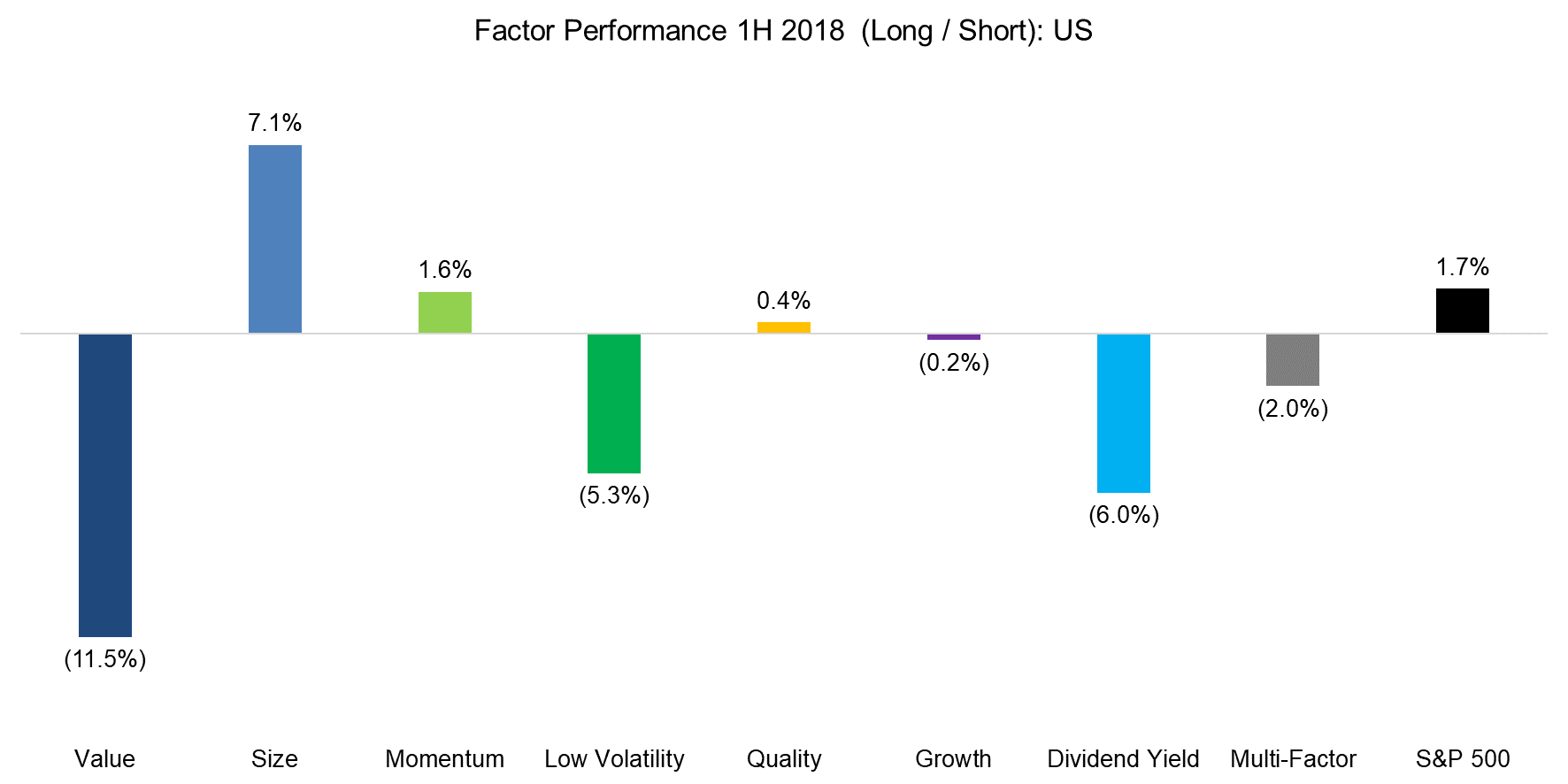
Source: FactorResearch
FACTOR PERFORMANCE 1H 2018: EUROPE
The factor performance in Europe is similar to the US. A key discrepancy remains the performance of the Low Volatility factor, which is negative in the US while positive in Europe. Perhaps this reflects investors expectations of interest rates rising faster in the US compared to Europe. Momentum generated the highest returns in Europe, which has diversified long and short portfolios from a sector perspective, especially compared to the US, where Momentum has a significant long exposure to the Technology sector. A shift in sentiment toward Tech stocks would impact Momentum in the US far more than in Europe.
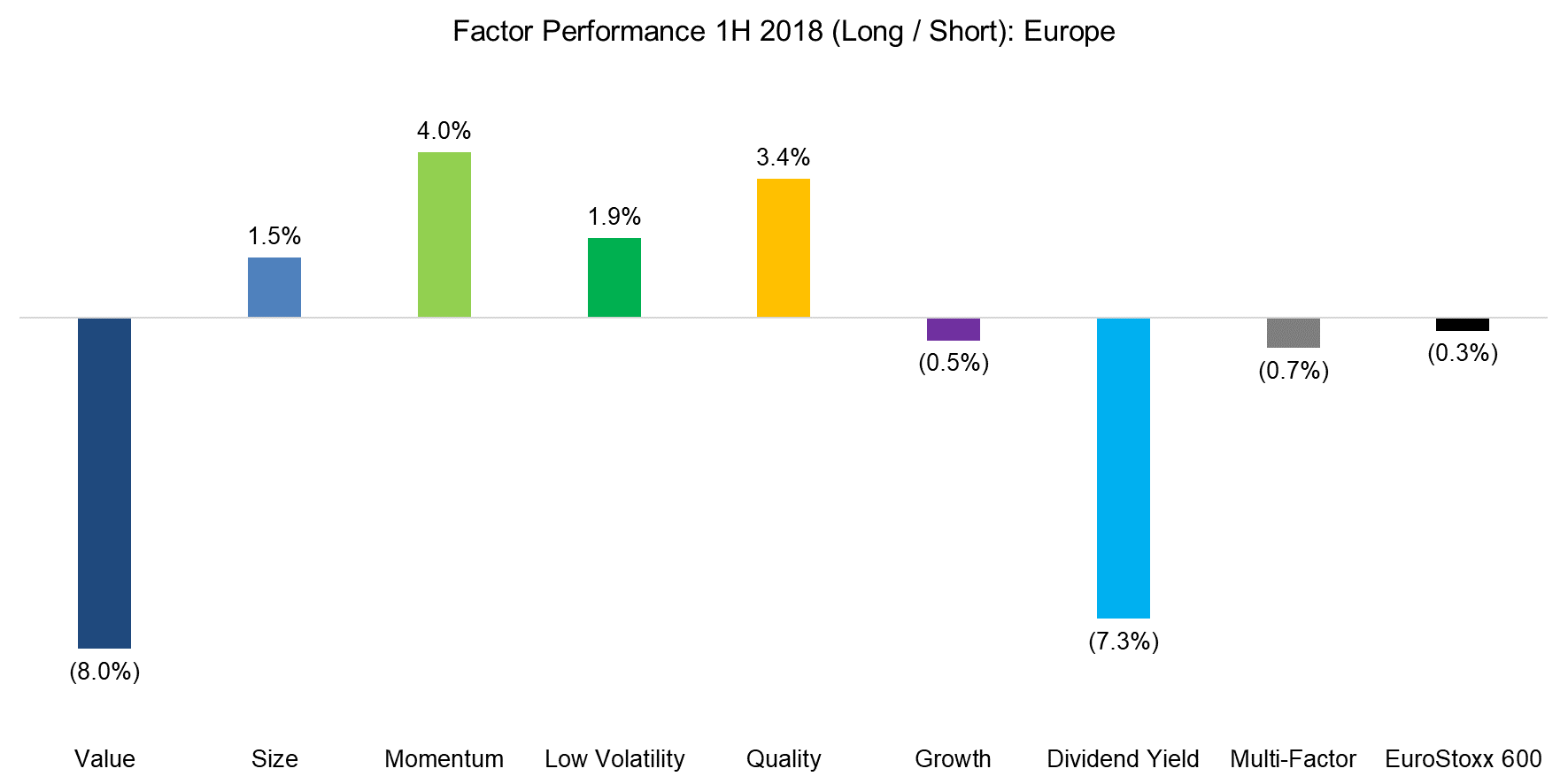
Source: FactorResearch
FACTOR PERFORMANCE 1H 2018: JAPAN
Factor performance in Japan is comparable to the US and Europe and especially pronounced for the Value factor, which performed worst in all three regions by a wide margin. The similar trends in factor performance highlight that some factors seem to have the same drivers that permeate borders and are global in nature, despite the economies having different growth rates and interest rate regimes (read Equity Factors In Japan).
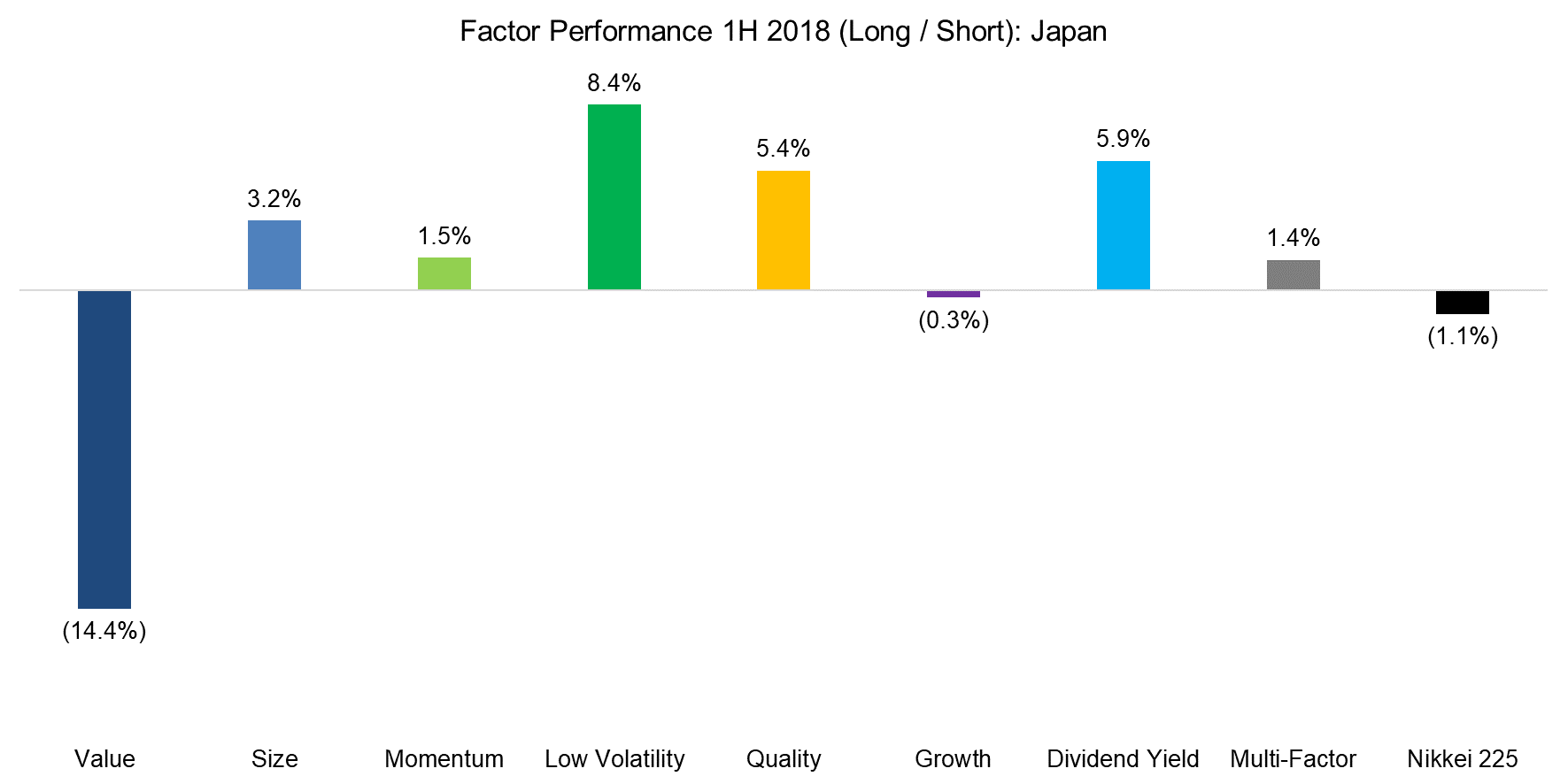
Source: FactorResearch
FACTOR PERFORMANCE 2018: PERFORMANCE CHART
The chart below shows the factor performance in 1H 2018 and we can identify one cluster of correlated factors, which comprises Growth, Quality and Momentum. The Technology sector currently contributes a significant amount of stocks to these three factors as Tech companies have shown strong growth in sales and earnings (Growth) and also feature high profitability and low levels of debt (Quality), which has led these stocks to outperform others (Momentum).
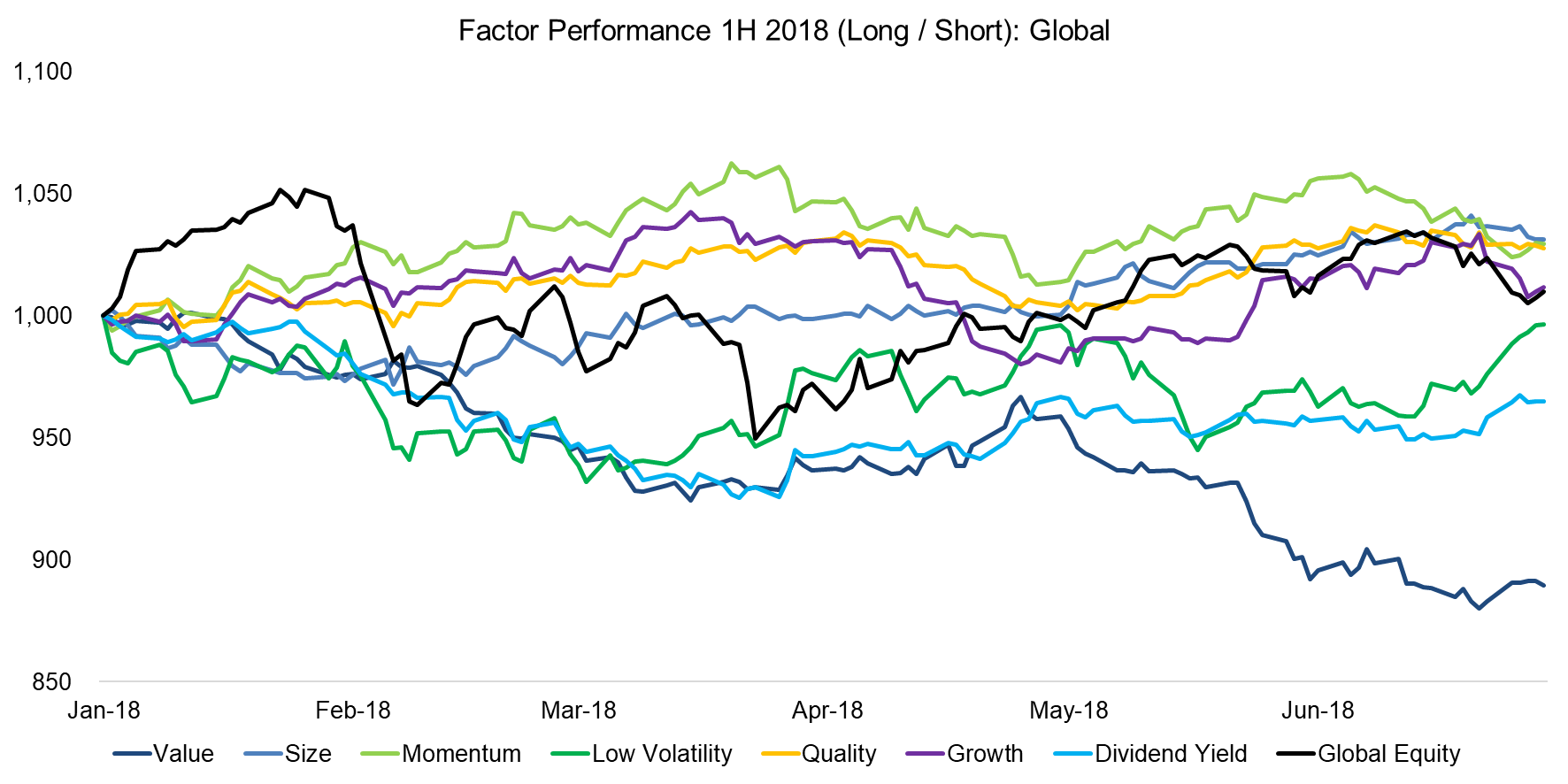
Source: FactorResearch
The correlation matrix below highlights the global one-year factor correlations. We can observe strong relationships between Momentum and Growth, Quality and Growth, and Low Volatility and Dividend Yield. Some of these are structural, e.g. Quality and Growth in the US have been correlated for many years. Low Volatility and Dividend Yield do not tend to be correlated, but both currently exhibit interest rate-sensitivity. Some factors show low or negative correlations, which can be used for creating diversified multi-factor portfolios.

Source: FactorResearch
FURTHER THOUGHTS
The factor performance in 1H 2018 reflects largely a continuation of 2017, which can be regarded as factor momentum. However, the strong performance of the Size factor in Q2 highlights how quickly the leaderboard can change. Empirical evidence from mutual funds, which directly or indirectly tend to replicate factors, indicates that the best performing funds over a three-year track record underperform thereafter while the worst performing funds outperform. Investors speculating on the mean-reversion of factors might find that Value is becoming more interesting.
ABOUT THE AUTHOR
Nicolas Rabener is the CEO & Founder of Finominal, which empowers professional investors with data, technology, and research insights to improve their investment outcomes. Previously he created Jackdaw Capital, an award-winning quantitative hedge fund. Before that Nicolas worked at GIC and Citigroup in London and New York. Nicolas holds a Master of Finance from HHL Leipzig Graduate School of Management, is a CAIA charter holder, and enjoys endurance sports (Ironman & 100km Ultramarathon).
Connect with me on LinkedIn or X.

